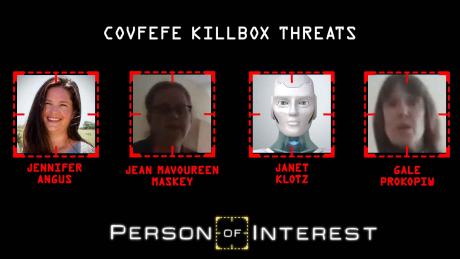M. Caroline Burton, MD1*, Mark B. Warren, MD2, Maria I. Lapid, MD2, J. Michael Bostwick, MD2
1Division of Hospital Medicine, Department of Medicine, Mayo Clinic, Jacksonville, Florida; 2Department of Psychiatry, Mayo Clinic, Rochester, Minnesota.
BACKGROUND: Munchausen syndrome by proxy (MSBP), more formally known as factitious disorder imposed on another, is a form of abuse in which a caregiver deliberately produces or feigns illness in a person under his or her care so that the proxy will receive medical care that gratifies the caregiver. Although well documented in the pediatric literature, few cases of MSBP with adult proxies (MSB-AP) have been reported. This study reviews existing literature on MSB-AP to provide a framework for clinicians to recognize this disorder.
METHODS: We searched Ovid MEDLINE, Ovid EMBASE, PubMed, Web of Knowledge, and PsychINFO, supplemented by bibliographic examination.
RESULTS: We identified 13 cases of MSB-AP. Perpetrators were caregivers, most (62%) were women, and many worked in healthcare. The age range of the victims was 21 to 82 years. Most were unaware of the abuse, although in 2 cases the victim may have colluded with the perpetrator. Disease fabrication most often resulted from poisoning.
CONCLUSIONS: MSB-AP should be included in the differential diagnosis of patients presenting with a complex constellation of symptoms without a unifying etiology and an overly involved caregiver with suspected psychological gain. Early identification is necessary so that healthcare providers do not unknowingly perpetuate harm through treatments that satisfy the perpetrator’s psychological needs at the proxy’s expense. Journal of Hospital Medicine2015;10:32–35. VC 2014 Society of Hospital Medicine
Asher first described Munchausen syndrome by proxy over 60 years ago. “Like the famous Baron von Mun- chausen, the persons affected have always traveled widely; and their stories like those attributed to him, are both dramatic and untruthful.”1 Munchausen syndrome is a psychiatric disorder in which a patient intentionally induces or feigns symptoms of physical or psychiatric illness to assume the sick role. In 1977, Meadow described the first case in which a caregiver–perpetrator deliberately produced physical symptoms in a child for proxy gratification.2 Unlike malingering, in which external incentives drive conscious symptom falsification, Munchausen syndrome by proxy (MSBP) is associated with fulfillment of the abuser’s own psy- chological need for garnering praise from medical staff for devoted care given a sick child.3,4
MSBP was once considered vanishingly rare. Many experts now believe it is more common, with a reported annual incidence of 0.4/100,000 in children younger than 16 years, and 2/100,000 in children younger than 1 year.5 It is a disorder in which a par- ent, often the mother (94%–99%)6 and often with training or interest in the medical field,5 is the perpe- trator. The medical team caring for her child often
views her as unusually helpful, and she is frequently psychiatrically ill with disorders such as depression, personality disorder, or prior personal history of somatoform or factitious disorder.7,8 The perpetrator typically inflicts physical harm, although occasionally she may simply lie about symptoms or tamper with laboratory samples.5 The most common methods of inflicting harm are poisoning and suffocation. Overall mortality is 6% to 9%.6,9
Although a large body of literature addresses pedi- atric cases, there is little to guide clinicians when vic- tims are adults. An obvious reason may be that MSBP with adult proxies (MSB-AP) has been reported so rarely, although we believe it is under-recognized and more common than thought. The primary objective of this review was to identify all published cases of MSB-AP, and synthesize them to characterize victims and perpetrators, modes of deceit, and relationships between victims and perpetrators so that clinicians will be better equipped to recognize such cases or at least include MSB-AP in the differential of possibilities when symptoms and history are inconsistent.
METHODS
The Mayo Clinic Rochester Institutional Review Board approved this study. The databases of Ovid MEDLINE, Ovid EMBASE, PubMed, Web of Knowl- edge, and PsychINFO were searched from inception through April 2014 to identify all published cases of Munchausen by proxy in patients 18 years or older. The following search terms were used: “Munchausen syndrome by proxy,” “factitious disorder by proxy,” “Munchausen syndrome,” and “factitious disorder.” Reports were included when they described single or multiple cases of MSBP with victims aged at least 18 years. The search was not limited to articles published in English. Bibliographies of selected articles were reviewed for reports identifying additional cases.
RESULTS
We found 10 reports describing 11 cases of MSB-AP and 1 report describing 2 unique cases of MSB-AP (Tables 1 and 2). Two case reports were published in French10,11 and 1 in Polish.12 Sigal et al.13 describes 2 different victims with a common perpetrator, and another report14 describes the same perpetrator with a third victim. One case, though cited as MSB-AP in the literature was excluded because it did not meet the criteria for the disorder. In this case, the wife of a 28- year-old alcoholic male poured acid on him while he was inebriated, ostensibly to vent frustration and coerce him into sobriety.15,16
Of the 13 victims, 9 (69%) were women and 4 (31%) were men. Of the ages reported, the median age was 69 years and the mean age was 51 (range, 21–82 years). Exact age was not reported in 3 cases. Lying about signs and symptoms, but not actually inducing injury, occurred in 3 cases (23%), whereas in 10 cases (77%), the victims presented with physical findings, including coma (3), rash (2), skin abscesses (2), syncope (1), recurrent bacteremia (1), and fluid overload (1). Seven (54%) of the victims were pois- oned, 2 via drug injection and 5 by beverage/food contamination. A perpetrator sedated 3 victims and subsequently injected them, 2 with gasoline and another with turpentine. Two of the victims were involved in business, 1 worked in childcare, 1 attended beauty school after graduating from high school, 1 attended college, and 1 was developmentally delayed. Victim education or occupation was not reported in 7 cases.
Of the 11 perpetrators, 8 (73%) were women, and 3 (27%) were men (note that the same male perpetra- tor had 3 victims). Median age was 34 years (range, 26–55 years), although exact age was not reported in 4 cases. The perpetrator was the victim’s mother in 3 cases, wife in 2 cases, son in 2 cases, and daughter, granddaughter, husband, companion, boyfriend, or prison cellmate in 1 case each. Five (38%) worked in healthcare.
All of the perpetrators were highly involved, even overly involved, in the care of their victims, frequently present, sometimes hovering, in hospital settings, and were viewed as generally helpful, if not overintrusive, by hospital staff. When confronted, 3 perpetrators confessed, 3 denied abuse that then ceased, and 4 more denied abuse that continued, culminating in death in 1 case. In 1 case, the outcome was not reported.8 At least 3 victims remained with their per- petrators. Two perpetrators were criminally charged, 1 receiving probation and the other incarceration. The latter began abusing his cellmate, behavior that did not stop until he was confronted in prison.
CONCLUSION/DISCUSSION
Our primary objective was to locate and review all published cases of MSB-AP. Our secondary aim was to describe salient characteristics of perpetrators, vic- tims, and fabricated diseases in hopes of helping clini- cians better recognize this disorder.
Our review shows that perpetrators were exclu- sively the victims’ caregivers, including mothers, wives, husbands, daughters, granddaughters, or com- panions. These perpetrators, many with healthcare backgrounds, were attentive, helpful, and excessively present. In the majority of cases, hidden physical abuse yielded visible disease. Less commonly, perpe- trators lied about symptoms rather than actually cre- ating signs of disease. The most common mode of disease instigation involved poisoning through bever- age/food contamination or subcutaneous injection. Geriatric and developmentally delayed persons appeared particularly vulnerable to victimization. Of the 13 victims, 5 were geriatric and 1 was develop- mentally delayed.
The adult cases we report are similar to child cases in that the perpetrators are caregivers; however, the caregivers of the adults are a more diverse group. Other similarities between adult and child cases are that physical signs occur more often than simply falsi- fying information, and poisoning is the most common method of disease fabrication. Suffocation, although common in child cases, has not been reported in adults. Though present in only a minority of cases, another feature distinguishing these cases from those
reported in the pediatric literature is the presence of collusion between the perpetrator and victim. When MSBP was first described, Meadow believed that vic- tims would reach an age at which the disorder would cease because they would fight back or report the abuse.2 In 7 of the adult cases, the victims were unknowingly poisoned; however, in 2 cases,17 the vic- tims knew what their mothers were doing to them and yet denied that they were harming them. To explain this collusion, Deimel et al. proposed Stock- holm syndrome, a condition in which a victim holds a perpetrator in high regard, despite experiencing at their hands what others might consider brainwashing and torture.
The data from the individual cases are sometimes frustratingly incomplete, with inconsistent reporting of dyad demographics and outcomes across the 13 cases, which compromises efforts to compare and con- trast them. However, because no published studies have thoroughly reviewed all existing cases of MSB- AP, we believe our review provides important insights into this condition by consolidating available informa- tion. It is our hope that by characterizing perpetrators, victims, and common presentations, we will raise awareness about this condition among healthcare pro- viders so that it may be included in the differential diagnosis when they encounter this dyad: a patient’s medical problems do not respond as expected to ther- apy and a caregivers appears overly involved or atten- tion seeking.
The diagnosis of a factitious disorder often presents an immense clinical challenge and generally involves a multidisciplinary approach.18 In addition to the incomplete data for existing cases in the literature, we recognize the ongoing difficulties in precise diagnosis of this disorder. Because a hallmark of pathology is secrecy at the outset and often denial, and even abrupt transition of care, upon confrontation, it is often very difficult, especially early on, to uncover patterns of perpetration, let alone posit a motive. We recognize that there may be some perpetrators who are moti- vated by something other than purely psychological end points, such as financial reward or even sexual victimization. And when alternate care venues are sought, clinicians are often left wondering. Further, the damage that may come to a therapeutic relation- ship by prematurely diagnosing MSB-AP is important to keep in mind. Hospitalists who suspect MSB-AP should consult psychiatry. Although MSB-AP is a diagnosis of exclusion and often based on circumstan- tial evidence, psychiatry can assist in diagnosing this disorder and, in the event of a confession, provide immediate therapeutic intervention. Social services can aid in a vulnerable adult investigation for patients who do not have capacity.
When Meadow first described MSBP, he ended his article by asking “Is this degree of falsification rare or is it under-recognized?” Time has answered Meadow’s question. Now we ask the same question with regard to MSB-AP, is it rare or under-recognized? We must remain vigilant for this disorder. Early recognition can prevent healthcare providers from unknowingly perpet- uating victimization by treating caregiver-induced pathology as if legitimate, thereby satisfying the perpe- trator’s psychological needs. Despite Meadow’s asser- tion that proxies outgrow their victimization, our review warns that advanced age does not preclude vul- nerability and in some cases, may actually increase it. In the future, the incidence and prevalence of MSB-AP is likely to increase as medical technology allows greater survival of cognitively impaired populations who are dependent on others for care. The elderly and developmentally delayed may be especially at risk.






Comments